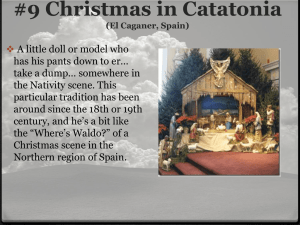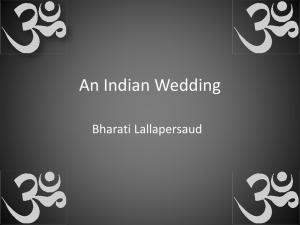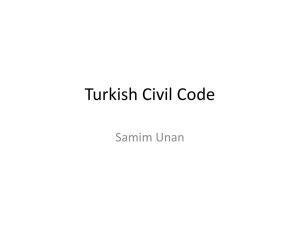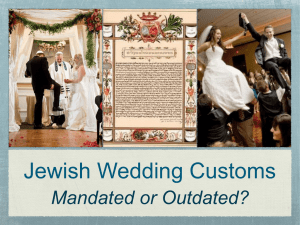roman weddings powerpoint
advertisement
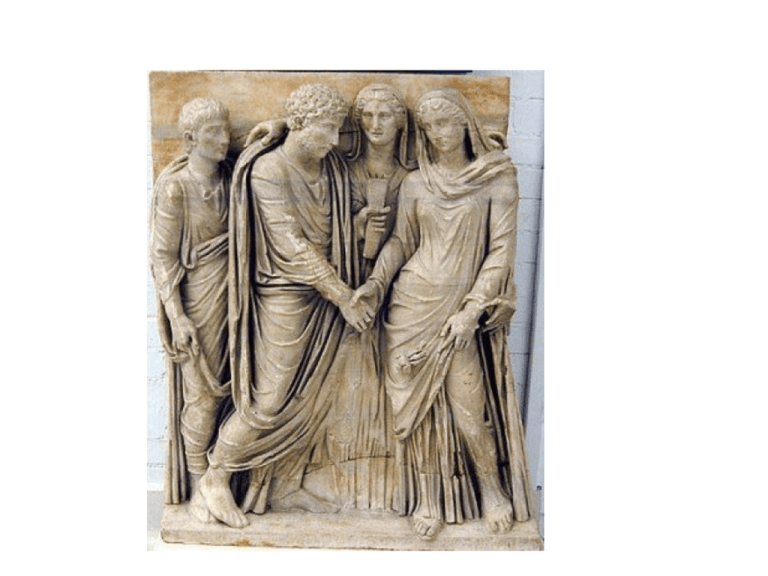
The world of Roman marriage. After studying the powerpoint and reading the primary source information the students will be able to: Differentiate various accepted forms of marriage. Compare marriage customs of today (in their own respective cultures) with those of the Romans. Discuss a Roman marriage including unique traditions of the Romans. Explain the Roman world as a whole and the Roman family by understanding how marriage functions within the society. Understand women by understanding societal expectations of marriage including ages for marriage and rights and responsibilities of a married woman. Roman Marriage I. Betrothal (sponsalia) a.Both bride and groom must be Roman citizens in order for conubium to exit. b. .Dowry had to be negotiated prior to the engagement c. Both bride and groom had to con sent to the engagement, as well as the paterfamilias of each d. minimium legal age formarriage – 14 for males; 12 for females – Girls were often married in their teens – Males married later and were often considerably older than the bride e. Engagements could be made between families very early in a child’s life, sometimes at birth, for political or financial reasons f. In upper‐class families, at least, there was usually a party given by the girl's ather to celebrate the engagement and inform friends Cum Manu Legal consequences of marriage for the Roman bride: a. The wife ceased to be a member of her birth family and became a legal member of her husband's family, under the control and guardianship (manus) of her husband; modern scholars call this "marriage cum manu." There were three methods for accomplishing this transfer Confarreatio 1. upper class 2. most lavish and expensive wedding 3. Special ritual involving an ancient type of grain called far, which was made into a special cake (farreum) 4. This ritual immediately transferred the bride from the control (potestas) of her paterfamilias to the control (manus) of her maritus 2. Coemptio – “Bride purchase” 1. all classes 2. Legal procedure involving a fictional "sale," where the groom paid a cooper coin of low value for bride (symbol of ancient weddings 3. This procedure immediately transferred the bride from the control (potestas) of her paterfamilias to the control (manus) of her maritus 3. Usus 1. all classes 2. It involved an automatic, passive transfer of the wife from the control (potestas) of her paterfamilias to the control (manus) of maritus after the wife had remained with her husband for a full year without interruption 3. This was based on an ancient law transferring ownership of an object to the person who remained in uninterrupted possession of that object for a full year 4. Wife could prevent the transfer of control by spending three consecutive nights away from her husband's home during the year (trinoctium) Sine Manu • Wife – member of birth family- not legal member of husband’s family • Under potestas of paterfamilias • By the last century of the Republic, this was by far the most common type of marriage; by the Empire, confarreatio, coemptio, and usus had become effectively obsolete. A series of wall frescoes describing a ritual preparation for marriage (or, some scholars believe, for initiation into a religious cult). A female attendant begins the special arrangement of the bride's hair, while beside the seated bride Eros holds up a mirror in which her face is reflected. The bride wears a saffron-colored gown, bound with a cloth belt perhaps tied in a Herakles knot; she wears yellow sandals, jewelry, and has a transparent veil wrapped around her and resting on her lap (detail). The final frame of the mural shows the Domina, fully draped in her palla, seated on a throne, displaying her wedding ring detail. Triclinium, Villa of the Mysteries, Pompeii, mid-1st century CE. Photos by Ann Olga Koloski-Ostrow, Brandeis University, 2009. Wedding Preparations Materials Required: • Annulus pronubus – wedding ring • Tabulae nuptiales – marriage contract specifying dowry arrangements Materials Discarded: • Toga praetexta • Childhood toys Bridal Wear • Flammeum – saffron veil • Lutei socci – shoes • Tunica recta – straight tunic • Nodus Herculis – belt tied knot of Hercules • Seni crines – hairstyle (usually divided into six braids) • • • • • • • • • • • Ceremony Most weddings in June (Juno- protected marriage bonds) – no weddings on feast days/holidays Ceremonies took place at home of paterfamilias Vows – Ubi tu Gaius, ego Gaia (used for all couples, brought good luck) – Clasping of Right Hand : dextrarum iunctio – • Pronuba – married woman in stable marriage joined the hands Friends & Family- witnesses – sealed tabulae nuptiales – Confarreatio – 10 witnesses – Coemptio – 5 witnesses Sacrifice (pig) Pompa – procession from bride’s house to groom’s house – Stolen from mom – recall Sabine women – Bride carried spindle & distaff to represent her repsonsibility to provide for family Proceeded by boys with torches(spina alba) thrown away once at groom’s house Yelling of insults by guests – supposedly for good luck Entering new house – – Rub doorway with lard, wreath the door with wool (domestic duties), carried over threshold by attendants, receive fire & water from groom Matrona (pronuba) – escorted bride to bridal chamber – Prayers for blessings over the marriage, removes all jewelry, puts the bride in the bed(lectus genialis), offers a sacrifice to hopefully have children, pronuba leaves, husband enters Guests still party outside the bedroom Bridal Procession in mosaic showing Philonoe about to wed Bellerophon; though they are characters from Greek mythology, the scene reflects a Roman wedding. The shy bride, assisted by her mother or a pronuba, is dressed in a saffron tunic with a wedding wreath hovering symbolically over her head. The groom stands on the right holding Pegasus, the winged horse. Between them stands painted on a terracotta urn. Four women are pictured: the mother at left Philonoe's father, Iobates, king of Lycia. Roman Tunisia. From the "House of the Nymphs." 4th century CE. Nabeul Archaeological Museum. (?), pronuba at right (?), musician with drum and the anxious-looking veiled bride in the center. The bride wears a special garment for the ceremony called the tunica recta or regilla, traditionally woven in one piece on an upright loom. The urn was made for a tomb. Centuripe, 3-2 century BCE. NY: Metropolitan Museum of Art. Cinerary urn in marble for Helius Afinianus, dedicated by his wife. He is dressed in a toga, holding a scroll; she wears a stola and palla. They stand in front of open doors, holding hands before an altar in the marriage pose dextrarum iunctio. Inscription: D[is] M[anibus] HELIO AFIN[iano] PUB[lico] AUG[urum] SEXTIA PSYCHE CONIUGI B[ene] M[erenti] [fecit]. Rome, 2nd century CE. Berlin, Pergamon Museum. Sarcophagus in marble of a freed couple, a young woman with a much older man, both in civic dress, depicted in the marriage pose dextrarum iunctio. Inscription: P[UBLIUS] AIEDIVS P[UBLI] L[IBERTUS] AMPHIO; AEIDIA P[UBLI] L[IBERTA] FAVSTA MELIOR. found on Via Appia, Rome, c. 30 BCE. Berlin, Pergamon Museum. Sestertius of Antoninus Pius, portraying two couples of the imperial family (Antoninus & Faustine Maior; Marcus Aurelius & Faustina Minor) in the marriage gesture before an altar. Antoninus holds a statuette of Condordia while his wife holds a scepter. Inscribed: CONCORDIAE S(enatus) C(onsulto). Rome, 140-4 CE. Berlin: Bode Museum. marble relief showing a veiled bride, followed by the pronuba, clasping hands (dextrarum iunctio) with the groom before an altar; on the left a huge male carries the sacrificial bull on his shoulder, on the right a maenad dances. Rome: Vatican, Bracchio Nuovo. Funerary tondo in marble of relief busts of a couple: she gazes at him with one hand on his chest and her arm around his shoulders, her gown having slipped off one shoulder (a pose reminiscent of Venus); her husband is in a citizen toga, holding a scroll (marriage document?). 250-270 CE. Boston, Museum of Fine Arts. Funerary Relief in marble of Aurelius Hermia and his wife Aurelia Philematio, one of earliest to commemorate legitimate marriage between freedpeople; they are portrayed as Roman citizens (see text in WRW, pp. 46-47). From tomb on Via Nomentana, c. 80 BCE. London, British Museum. Funerary Inscriptions 1. Read the following instructions on reading funerary inscriptions http://pompeii.virginia.edu/tti/eb-insc/eb-insc-list.html • http://www2.cnr.edu/home/araia/dasumia_s oteris.html • http://www2.cnr.edu/home/araia/julia_caprio la.html • http://www2.cnr.edu/home/araia/nothi_coni unx.html Please complete the following questions. • A Roman woman was someone’s wife, and someone else’s mother. Do you think an ancient Roman woman saw herself this way? Give reasons why or why not. • Consider the role of a dowry in an upper-class Roman marriage. If a couple divorced, the husband was legally required to return his wife’s dowry in full. In what ways would this work to a woman’s advantage both during her marriage and if she were divorced? • Roman marriages were arranged for the sake of political alliances, as a means of sharing property and wealth in the upper-classes, and to produce legitimate heirs. Do you think any of these considerations are still taken into account in marriages today? Consider not just marriage within your own community, but in other countries, cultures, and classes. Interpret the 3 funerary inscriptions that have been provided to the best of your ability. Explain how they support the information we have studied about the status of women in Roman society? Were you surprised by any of the inscriptions? How do they reflect the values of Roman society ? •



